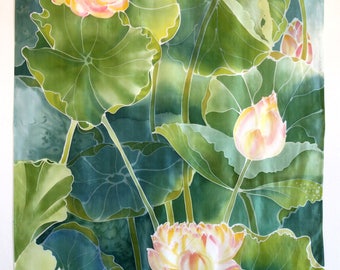

They are only accessible by boat with outboard engines, which speeds things up until the engine is cut, and you are paddled almost silently to a jetty, where thankfully you will be helped out of the low canoes onto the bamboo walkways. Named after their daughter, their simple workshop is built on stilts sunk deep into the lake’s bed, as are all the structures on Inle Lake. On the advice of our homestay host, we eventually found a workshop that had a distinct family feel to it.
#Lotus silk scarf free#
We travelled areas of the 45 square miles of the lake, past the famous fishermen, sculling their boats with one leg while keeping their hands free to cast their nets, to visit workshops that mainly cater to tourists.

The same labour intensive processes are used to this day in small workshops dotted around the lake in order to produce exceptional and unique fabrics. Recently, there has been a resurgence in this handicraft. The lotus stems can only be harvested in the rainy season of May to early October, during which time y ou can pull each flower stem individually from below the surface of the water, and each stem will (if you're are lucky and don’t break them!) give you enough fibres for a fraction of the silk needed to weave a scarf. To achieve this, she harvested stems from under the beautiful and sacred lotus flowers found growing on the majestic Inle Lake.

Legend has it that the origins of lotus silk lie in one Myanmar woman’s devotion to her faith.Īround a century ago, a woman from Inle Lake, Myanmar, decided to make a robe worthy for the incumbent monk at her local temple. They symbolise the mind, the soul, enlightenment and purification of the body. Lotus flowers are sacred to Hindus and Buddhists.


 0 kommentar(er)
0 kommentar(er)
